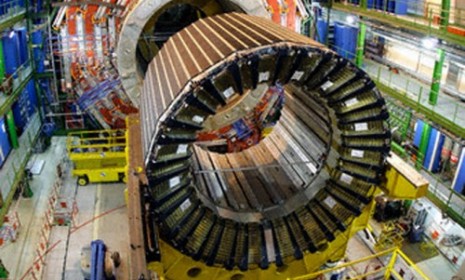The Big Bang machine
The Large Hadron Collider, now in a start-up phase, will search for the tiniest pieces of the universe. Why bother?

What is the Large Hadron Collider?
It’s the largest machine in the world, built to unlock the deepest secrets of the universe. Located 300 feet below ground along the border between France and Switzerland, the LHC is housed inside a mammoth circular tunnel measuring 17 miles around. The tunnel contains two large tubes lined with more than 1,000 powerful magnets cooled by helium to just above absolute zero, so that they offer virtually no resistance to the current flowing through them. The tubes channel beams of lead ions and hydrogen protons and neutrons—the largest components of atoms—belonging to the hadron family of particles. Two months ago, after 20 years of preparation, many setbacks, and an investment of more than $10 billion, international scientists finally test-fired the beams at each other, producing subatomic collisions of unprecedented energy.
Why is so much energy needed?
The Week
Escape your echo chamber. Get the facts behind the news, plus analysis from multiple perspectives.

Sign up for The Week's Free Newsletters
From our morning news briefing to a weekly Good News Newsletter, get the best of The Week delivered directly to your inbox.
From our morning news briefing to a weekly Good News Newsletter, get the best of The Week delivered directly to your inbox.
Scientists are hoping to re-create the conditions that existed in the first one-trillionth of a second after the Big Bang—the moment, roughly 13.7 billion years ago, when all matter and energy is believed to have exploded from a point smaller than an atom, bringing the fundamental particles and forces of nature into being. Test-firings have already reached energies of more than 2 trillion volts, the most ever produced on Earth. But starting in early 2010, scientists will push the beams even faster, until they’re circling the tunnel at more than 11,000 times a second, just below the speed of light. Then, researchers could catch a glimpse of these fundamental forces and particles in the debris from the collisions.
What are they hoping to find?
A subatomic particle called the Higgs boson—the so-called God particle. According to the mathematical equations that make up the reigning theory of physics, known as the Standard Model, the Higgs boson is the piece of the atom that endows all the other pieces with their mass. It is “what allows us to exist,” says physics professor Tejinder Virdee of Imperial College London. “Without the Higgs boson we would all be puffs of radiation.” Until the LHC was switched on, there was no device on Earth capable of smashing atoms together at the energies necessary to produce the Higgs.
All this for one tiny particle?
A free daily email with the biggest news stories of the day – and the best features from TheWeek.com
Not really. By stripping atoms down to their most basic elements, the LHC experiments could also help solve puzzles that have perplexed scientists for decades. Physicists still can’t explain why the universe is expanding rather than contracting. LHC data could help identify the force that has been steadily pushing the universe outward since the Big Bang. The data might also help explain why the visible universe accounts for only 4 percent of the universe’s total mass. When physicists this year crank up the LHC to its highest energies, the collisions they produce could throw off clues to the whereabouts of the remaining, invisible mass, which scientists call “dark matter.” Although such knowledge might seem useless, scientists say the search for it is a basic human drive. “Humankind differs from a collection of ants,” says physicist Peter Jenni. “We need to understand the mechanisms of life and the universe.”
What if they don’t find these particles?
They may have to rethink the laws of physics. In recent years, physicists have built on the Standard Model to spin elaborate new theories to explain the universe—such as the proposition that it is composed of tiny, vibrating “strings” of energy, or that it is merely one of an infinite number of universes, all existing simultaneously. The LHC promises to produce staggering amounts of data—enough every year to fill a stack of CDs 12 miles high—that physicists can use to test these theories. “There have been thousands of theoretical papers,” says physicist John Ellis. “I’ve written hundreds of them myself. What if it all turns out to be a pile of garbage?”
Is the collider safe?
Experts insist that it is, but some amateur physicists say that if the experts are wrong, we could all be doomed. In 2008, a high school teacher in Hawaii filed a federal lawsuit demanding that the LHC be shut down; he claimed that the LHC collisions could produce a “black hole”—a gravitational field so massive and dense that it would swallow the LHC, the surrounding countryside, and possibly Earth itself. The lawsuit was tossed out. LHC scientists dismiss such worries, arguing that any black holes produced would be so small and short-lived that they could do no damage. LHC director Rolf-Dieter Heuer points out that subatomic particles are constantly crashing into Earth’s atmosphere from outer space, occasionally producing the same sort of transient black holes that may occur in the LHC. “And look,” says Heuer. “We are still here.”
The time traveler’s revenge
The LHC has been plagued with problems since it was first powered up in 2008. Days after it was switched on, two magnets vaporized when their connections failed, causing a fire and the release of thousands of gallons of supercold helium, which triggered an underground snowfall. Last fall, the collider was shut down again when a capacitor failed, after a passing bird dropped a bit of baguette on the machinery. Now two respected physicists have suggested those failures were no mere accidents. In a paper dense with mathematical calculations, Denmark’s Bech Nielsen and Japan’s Masao Ninomiya suggest—with tongues firmly in cheek—that nature itself is sabotaging the LHC, to prevent scientists from discovering the universe’s innermost secrets. The potential discovery of the Higgs boson, they argue, is so “abhorrent to nature” that some force—perhaps even a force from the future—thwarts scientists whenever they get close to finding it. Russian physicist Dmitri Denisov says their theory is “clearly crazy,” but concedes it’s plausible—barely. American physicist Robert Roser agrees. “Sometimes,” he says, “outlandish papers turn out to be the laws of physics.”
-
 Political cartoons for December 16
Political cartoons for December 16Cartoons Tuesday’s editorial cartoons include calibrating fonts, Christmas classics, and more
-
 Cryptocurrency and the future of politics
Cryptocurrency and the future of politicsIn The Spotlight From electoral campaigns to government investments, crypto is everywhere and looks like it’s here to stay
-
 Ssh! UK libraries worth travelling for
Ssh! UK libraries worth travelling forThe Week Recommends From architectural delights to a ‘literary oasis’, these are some of the best libraries around the country